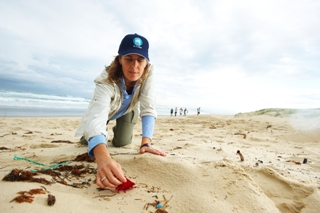Sep 16 2014
In a report released today, CSIRO scientist Denise Hardesty says her team surveyed sites approximately every 100 km along the Australian coastline.
 CSIRO researcher Denise Hardesty inspects debris on North Stradbroke Island.
CSIRO researcher Denise Hardesty inspects debris on North Stradbroke Island.
“We found about three-quarters of the rubbish along the coast is plastic,” she says. “Most is from Australian sources, not the high seas, with debris concentrated near cities.”
She says the density of plastic in Australian waters ranges from a few thousand pieces of plastic per square kilometre to more than 40,000 pieces.
Marine debris includes items such as glass or plastic bottles, cans, bags, balloons, rubber, metal, fibreglass, cigarettes and other manufactured materials that end up in the ocean and along the coast. It can smother coral reefs, kill wildlife, and may pose a threat to human health.
“Approximately one third of marine turtles around the world have likely ingested debris, and this has increased since plastic production began in the 1950s,” Dr Hardesty says. “We also estimate that between 5,000 and 15,000 turtles have been killed in the Gulf of Carpentaria after becoming ensnared by derelict fishing nets mostly originating from overseas.”
She says the Tasman Sea south of Australia is a global hotspot for seabird impacts.
“We found that 43 per cent of seabirds have plastic in their gut. Globally, nearly half of all seabird species are likely to ingest debris, eating everything from balloons to glow sticks, industrial plastic pellets, rubber, foam and string.”
“By garnering the information needed to identify sources and hotspots of debris, we can better develop effective solutions to tackle marine debris,” says Dr Hardesty.
The research is part of TeachWild, a national three-year research and education program developed by Earthwatch Australia in partnership with CSIRO and Shell Australia’s National Social Investment Program.
“This innovative national partnership has engaged with thousands of students and teachers, says David McInnes, Chief Executive Officer at Earthwatch. “It reaches more than one million Australians to help increase our understanding of the problems of marine debris.”